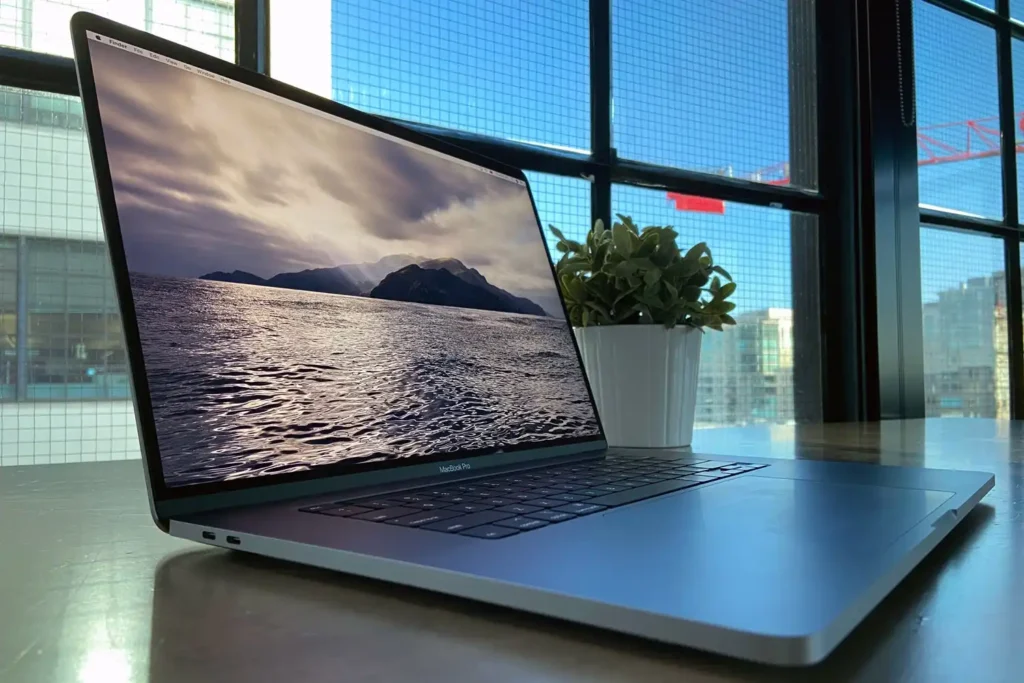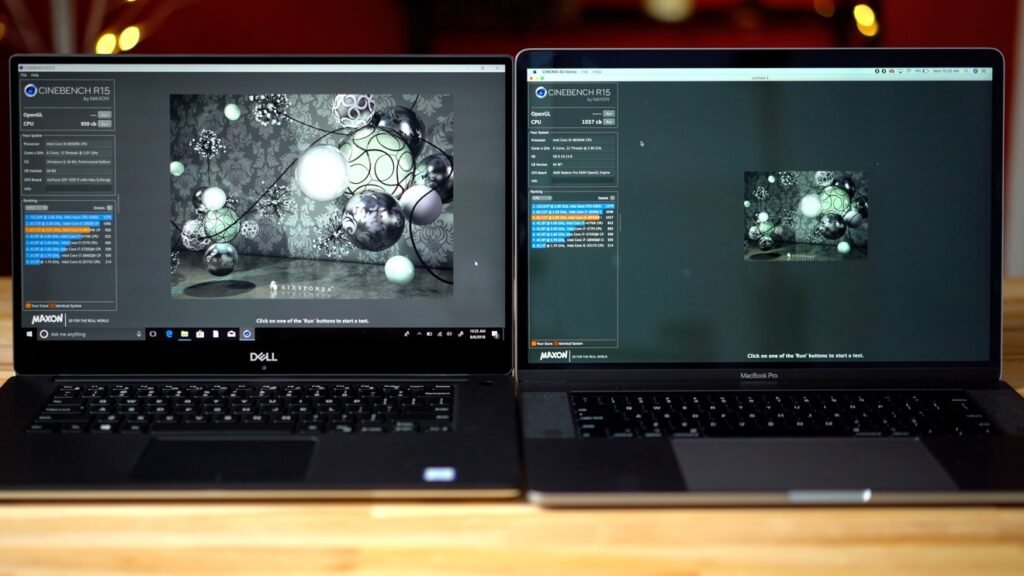Compare the Apple MacBook Pro 16 vs. Dell XPS 15 Which Powerhouse Reigns Supreme in our detailed showdown
The Apple MacBook Pro 16 and Dell XPS 15 9530 are top contenders in the 15-inch laptop category, ideal for gaming, content creation, video editing, and demanding work. The MacBook Pro 16 stands out with its powerful M1 chips, exceptional display, and premium build, making it perfect for professionals needing superior performance. Meanwhile, the Dell XPS 15 offers a more budget-friendly option with customizable hardware, providing strong performance at a lower cost.
Quick Summary: Apple MacBook Pro 16 vs. Dell XPS 15 9530
| Feature | Apple MacBook Pro 16 | Dell XPS 15 9530 |
|---|---|---|
| Dimensions & Weight | 14.01″ x 9.77″ x 0.66″, 4.8 lbs | 13.57″ x 9.06″ x 0.71″, 4.23 lbs |
| Processor | Apple M1 Pro/M1 Max | Intel Core i5/i7/i9 |
| Graphics | Integrated Apple GPU | Intel Iris Xe, Nvidia RTX 4050/4060/4070 |
| RAM | 16GB/32GB/64GB | 8GB/16GB/32GB/64GB DDR5-4800MHz |
| Display | 16.2″ Liquid Retina XDR | 15.6″ FHD+ or 3.5K OLED |
| Storage | 512GB – 8TB SSD | 512GB – 8TB PCIe SSD |
| Battery | 100 watt-hours | 86 watt-hours |
| Price | Starting at $2,499 | Starting at $1,499 |
| Rating | 5 out of 5 stars | 3.5 out of 5 stars |
Pros and Cons
| Feature | Apple MacBook Pro 16 | Dell XPS 15 9530 |
|---|---|---|
| Pros | – Exceptional performance with Apple M1 Pro/M1 Max chips – Superior 16.2″ Liquid Retina XDR display – Premium build quality and design – Longer battery life | – More affordable starting price – Highly customizable hardware options – Slightly lighter and more portable – Versatile display choices, including a stunning OLED option |
| Cons | – Higher starting price – Heavier, making it less portable – Limited customization options compared to the XPS 15 | – Average battery life compared to the MacBook Pro – Lower resolution 720p webcam – Build quality is solid but not as premium as the MacBook |

XPS 15 Laptop
Design
When choosing the right operating system, your preference plays a crucial role. If you’re already loyal to one, your decision is practically made, as the hardware will naturally follow. However, if you’re undecided, it’s reassuring to know that both the MacBook Pro 16 and the XPS 15 excel in design and durability.
The MacBook Pro 16 is crafted from a single block of aluminum, delivering a solid and seamless construction. It embraces a minimalist and refined elegance, available in silver or space gray. Its uniform design is subtly interrupted only by the black keyboard section and the iconic Apple logo, exuding a sense of quality and sophistication.
The XPS 15, on the other hand, boasts a combination of machined aluminum and either carbon fiber (with a black keyboard deck) or glass fiber (with a white keyboard deck), ensuring a robust and premium feel. With its more intricate design, the XPS 15 features silver or frost aluminum for the lid and chassis, paired with a contrasting black carbon fiber or white glass keyboard deck. The double-anodized chrome sides not only enhance the sleek look but also offer added scratch resistance.
Ultimately, both laptops are visually appealing and well-constructed, with the choice between them coming down to personal taste.

MacBook Pro 16
The MacBook’s Magic Keyboard, despite its relatively short travel of just 1mm, stands out as one of the best keyboards available on any laptop today. Its crisp, snappy, and responsive feel makes it ideal for long typing sessions. In comparison, the Dell XPS 15’s keyboard is also impressive, offering more travel and a precise mechanism that complements its large keys and ample key spacing.
When it comes to touchpads, the MacBook Pro 16 is a step ahead. While the XPS 15 features a commendable touchpad that’s large by Windows 11 standards and supports Microsoft Precision touchpad drivers, it still falls short of Apple’s expansive Force Touch touchpad. Although the haptic feedback method on the MacBook may take some time to get used to, it quickly becomes second nature, providing an unmatched responsive experience with the multitouch gestures supported by MacOS.
The MacBook Pro 16 also excels in webcam quality, featuring an excellent 1080p camera that significantly outperforms the XPS 15’s 720p webcam. Both laptops offer passwordless login options—Dell with its fingerprint scanner and facial recognition for Windows Hello, and Apple with its Touch ID fingerprint reader—each providing seamless and secure authentication.
In terms of connectivity, the MacBook Pro 16 offers a broader range of ports, including a full-size HDMI port, a full-size SD card reader, three USB-C ports with Thunderbolt 4, and a 3.5mm audio jack. On the other hand, the XPS 15 includes a USB-C 3.2 Gen 2 port, two USB-C ports with Thunderbolt 4, a 3.5mm audio jack, and a full-size SD card reader. Both laptops support the latest Wi-Fi 6E and Bluetooth 5.2 standards, ensuring robust wireless connectivity.
Performance
The MacBook Pro 16 offers a choice between Apple’s M2 Pro and M2 Max CPUs. The M2 Pro features a 12-core CPU (eight performance and four efficiency cores) paired with a 16-core GPU, while the M2 Max also includes a 12-core CPU but upgrades the GPU to either 30 or 38 cores. Both configurations excel in CPU-intensive tasks and creative workflows, showcasing remarkable speed and efficiency. Although our review focused on the MacBook with the M1 Pro chip, we included results from the MacBook Pro 14 equipped with the high-end M2 Max as a reference. The 16-inch model is expected to deliver even faster performance.
On the other hand, the Dell XPS 15 comes equipped with Intel’s 45-watt 13th-gen CPUs. Options include the Core i5-13500H (four Performance cores, eight Efficient cores, and 16 threads), the Core i7-12700H (six Performance cores, eight Efficient cores, and 20 threads), and the Core i9-12900HK (matching the Core i7’s core and thread count but with a higher 5.4GHz max Turbo frequency). This lineup delivers improved performance over Intel’s 12th-gen CPUs and competes well with the M1 Pro in most benchmarks.
For instance, when set to performance mode, the XPS 15 outperformed the M2 Max in the Handbrake test, which encodes a 420MB video as H.265. However, it lagged behind in multi-core benchmarks like Geekbench 5 and Cinebench R23. In single-core tasks, Intel’s CPU demonstrated superior speed, while the MacBook Pro 14’s M2 Max slightly edged out in the Pugetbench Premiere Pro benchmark, running in a live version of Premiere Pro.
Where the XPS 15 holds an advantage is in gaming, thanks to its discrete Nvidia GeForce RTX 4070 GPU, though the performance difference in gaming isn’t drastic.
Both laptops are more than capable for creative applications, but the MacBook Pro 16 stands out as the faster option for demanding creators.

Display
The MacBook Pro 16 features a singular, top-tier display option: a 16.2-inch Liquid Retina XDR (Mini-LED) panel with a 16:10 aspect ratio and a resolution of 3,456 x 2,234. This display delivers exceptional performance, boasting an impressive contrast ratio of 475,200:1 for deep, inky blacks and a peak brightness of 475 nits. It covers a wide color gamut with 100% of sRGB and 90% of AdobeRGB, and offers outstanding color accuracy with a DeltaE of 1.04 (where less than 1.0 is considered excellent). The Mini-LED technology also allows for incredibly bright HDR content, making the MacBook Pro 16 one of the best laptops for streaming media.
In comparison, the Dell XPS 15 provides a range of display options for its 15.6-inch, 16:10 panel, including non-touch Full HD+ (1,920 x 1,200), touch-enabled UHD+ (3,840 x 2,400) IPS, and a 3.5K (3,456 x 2,160) OLED version. The OLED display, which we reviewed, offers a remarkable experience with high brightness at 391 nits, though slightly less than the MacBook Pro 16. It features an excellent contrast ratio of 381,130:1, providing deep blacks. The color gamut is even wider than that of the MacBook, covering 100% of sRGB and 96% of AdobeRGB, with a superior color accuracy of 0.42.
Both displays excel in catering to creators, offering wide and accurate colors and true blacks. They are also ideal for productivity tasks and media consumption, with each laptop bringing its own strengths to the table.

XPS15 9530
Price
The MacBook Pro 16 is undoubtedly the superior laptop, but it comes at a premium price. This is where the MacBook Pro 16 and Dell XPS 15 take different paths.
Dell’s XPS 15 starts at a much more affordable $1,499, offering an Intel Core i5-13500H, 8GB of RAM, a 512GB SSD, Intel Arc A370 graphics, and a 15.6-inch Full HD+ non-touch display. On the higher end, you can configure it to a powerful setup with a Core i9-13900HK, 64GB of RAM, a 2TB SSD, an Nvidia GeForce RTX 4070, and a stunning 3.5K OLED display, all for $4,349.
In contrast, the MacBook Pro 16 starts at $2,499 for an M2 Pro with 12 CPU cores, 19 GPU cores, 16GB of RAM, and a 512GB SSD. For those seeking the ultimate performance, you can push the price up to $6,499 for an M2 Max with 12 CPU cores, 38 GPU cores, 96GB of RAM, and an 8TB SSD.
The MacBook Pro 16 is the better all-around laptop, offering unmatched performance at the high end, exceptional battery life, and a spectacular display—making it the top choice for the most demanding creators. However, Dell’s XPS 15 is a strong contender for mainstream users, offering excellent performance and features at a significantly lower price.
Ultimately, the choice comes down to your budget. If you’re willing to invest in the best, the MacBook Pro 16 delivers in every aspect. But if you’re looking for a capable, high-performing laptop without breaking the bank, the XPS 15 is a fantastic alternative.

